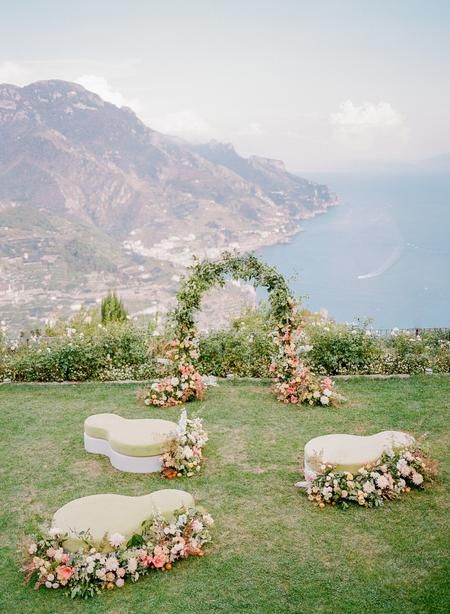Let’s have a look at the most frequently asked questions about wedding ceremonies.
The thing is — nowadays, you can do pretty much whatever you like.
You can opt for an extended bridal party of 12, or not have any whatsoever. There is no right answer for everyone, only what feels comfortable for you.

What is the order of entrance procession?
There is, of course, a traditional order which you can choose, and it goes like this. Bridesmaids enter first, escorted by groomsmen or alone. The maid or matron of honour enters last accompanied by the best man. Ring bearer and flower girl follow the adult party, they can enter one by one or together. If kids are old enough, they can stay at the altar together with the rest of the wedding party, otherwise, it’s best to have them sit with their parents once they walked the aisle (consider sitting their parents in one of the front rows). And finally, the last comes the bride. For same-sex marriages, the couple can choose to walk the isle together or one by one, or maybe skip the procession altogether.
Nowadays, however, you can easily mix things up and create the order of the ceremony that you feel comfortable with. The groom can walk in first, on his own or accompanying his parents, or the couple can walk in together… Just think what feels natural to you!
How to arrange ceremony sitting? What is the correct bride’s and groom’s side?
However, if you’re planning a more casual civil or symbolic ceremony, the seating and position of bride and groom at the ceremony is not heavily regulated.
You might want to change your standing position following a more flattering angle for photography, and equally, you can let your guests choose the place they’re comfortable at. This also helps for everyone to get to know each other quicker and generally break the ice.

What type of ceremony is best to have?
There are a lot of different ceremony types to choose from, and the ultimate decision depends on your personal views, wedding location and the timeline of the day.
- Civil/legal ceremony is a registration of the marriage by the official city hall/legal office. Some countries allow legal registration to happen on non-governmental sites, others restrict this option to city halls only. With this in mind, check the rules of the country and the venue you’re planning your wedding at to find out whether you can have the legal signing on the day, or you’ll need to do it separately. In the UK, look for venues that hold their marriage license if you wish to get legally married on the actual wedding day directly at the venue.
- Religious ceremony normally happens inside the place of religious worship: a church, a synagogue, a mosque, a temple and so on. Some will allow their priests to bless the marriage outside of places of worship (for instance, if the wedding is happening at a private estate/wedding venue/etc), but this needs to be discussed personally with your local religious community.
- Symbolic ceremony is a purely emblematic exchange of vows, with optional readings/additions from the master of ceremony, guests, etc. Symbolic ceremonies allow for more personal expression freedom and creative approach but have no legal power. You can choose to incorporate legal and symbolic ceremonies together, or alternatively, sort all the paperwork in advance and only focus on symbolic vow exchange on the wedding day itself.

What is the best time of the day to have the ceremony?
Most couples think of the ceremony as one of the most anticipated moments of the wedding day. And with this, you’d want to make sure that you have the best possible photographs to capture the memories of the moment, especially that it all happens so fast on the day.
Which is why, if you’re planning on a ceremony at an outdoor location, I always find it best to plan the ceremony timing around the light on the day. The best light for photos is the golden hour — around 1 hour before sunset — and you want to have that time for your portrait photos. Most ceremonies take 15-30 minutes depending, so schedule yours around 30 min before the golden hour starts.
That way the light already be soft enough to create flattering images of the ceremony itself and will give you an ample time for family photos afterward, before the two of you sneak out for a few shots of married bliss.

Does the bride wear her engagement ring for the ceremony?
The tradition asks married woman to wear her wedding band first, closer to heart, then followed by the engagement ring. With this in mind, you can either choose to remove the engagement ring for the ceremony, and put it back on later, or move it to your right hand just for the ceremony, so your husband-to-be can put the wedding band on first.
Personal or template vows?
Some people might not feel completely comfortable with sharing personal things in front of a crowd of guests, and if that’s the case for you, do not feel obliged to do it and simply opt for the offered ready-made script: they’re still meaningful and powerful.

The wedding ceremony is a beautiful moment that you will cherish in your memory for the rest of your life. Make sure that yours is meaningful for both of you and you feel comfortable with every single moment of it.
If you have more questions about your wedding ceremony or any wedding-related questions, do not hesitate to reach out to Xenia Motif. With the experience of planning and executing weddings in Italy, Spain, France, Thailand, Indonesia, The UK, we'll gladly help with your wedding in any part of the world!